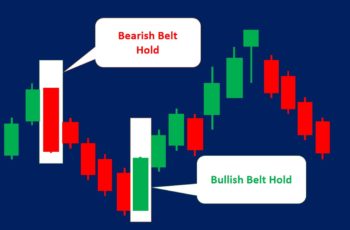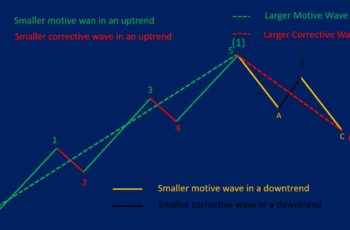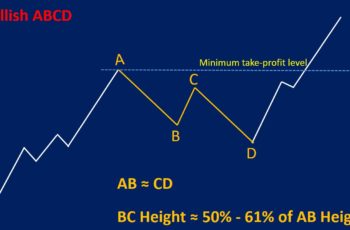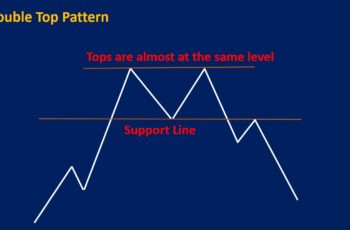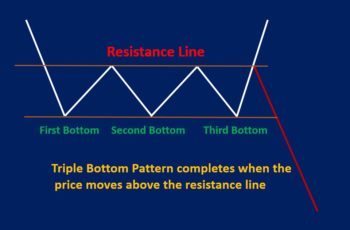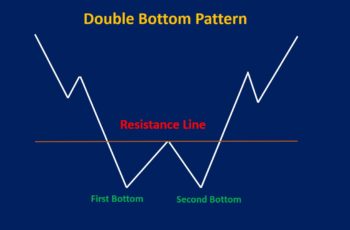Doji candlestick patterns are single candle patterns that appear on the chart of financial assets, and they mean uncertainties. And, identifying uncertainties in a critical moment is valuable for risk management.
In the beginning, let’s learn what a doji candlestick is.
What Is a Doji Candle?
A doji candlestick is a candlestick that has a tiny body and can have one of the shadows or both of them, or none of them.
Or in other words, a doji is a candlestick in which the opening and closing prices are the same or almost the same.
A perfect doji is a candle whose closing and opening price are exactly the same, without any flexibility.
However, we consider a candle as a doji if the difference between opening and closing prices is a few cents or points. A small positive or negative price movement in a session does not impact the whole market. Specifically, if the timeframe is daily and larger.
Generally, doji candlestick patterns mean indecision, tiredness, and caution. But they can be both reversal and continuation patterns, depending on where they appear.
Notice that candlestick patterns, including doji patterns, are more helpful in the stock market and a larger timeframe such as daily, weekly and monthly.
This article explains doji candlestick patterns and provides you with five examples. Additionally, it explains how to trade them.
Types of Doji Candlestick Patterns
Based on their shadows, there are five types of Doji Candlestick Patterns.
1. Classic Doji Candlestick Pattern
Classic Doji has short shadows in both directions and expresses indecision.
Based on our experiences, a classic doji is more likely to be a continuation pattern than a reversal. And, if you lower the time frame, it is more likely to see a continuation chart pattern such as a flag or a wedge formation.
However, if a doji appears after a long time of trending, then the chance of reversal increases. If not, it is more likely to be a continuation pattern or a time for rest.
As mentioned, it is more likely, not certain.
Example of Classic Doji Candlestick Pattern
In the following chart (if you can not see it clearly, open in a new tab), in a weekly chart, from Nov 2020 to Sep of 2021, there are five classic doji. They are not perfect doji but we consider them doji because they have tiny bodies.
The first doji appears in the middle of the trend, one candle after a short period of bullish correction. Because it passed a correction, it is less likely to be a reversal pattern. And, the price continued rising.
The second doji acted as a support. And, the price stopped falling further. Furthermore, a candle before this doji has a small body and relatively long tails, which is another reversal warning.
And, the third, fourth, and fifth warned of a reversal or correction, which turned out to be a correction. Additionally, the momentum technical indicator at the bottom of the chart went sideways when the Moving Average (MA) was going upward, warning the tiredness of the market.
2. 4 price Doji Candlestick Pattern
It is known as a four-price doji because all prices in a candlestick, opening, closing, highest, and lowest prices are the same. In other words, a 4-price doji means that bulls’ power equals bears’ power. Or, a 4-price doji means that volatility is the lowest.
A four-price candlestick indicates indecision and does not predict future movements. However, if there are multiple four-price doji, and they fall on a small slope, it is a bullish pattern. And, if the slope is small and positive, it is a bearish pattern.
Notice that during an indecision moment, it is more likely the current trend continue than reverse. It will only reverse if more investors are convinced that the direction should change.
Example of 4 Price Doji Candle
Finding a perfect 4-price doij on a chart is difficult because bulls and bears always compete. And, it is difficult to find a situation in which bulls and bears are equally strong or weak.
In fact, in the daily or weekly chart, I do not see any perfect 4-price doji, probably in months. And you may not see either.
However, in short period candlestick forex pairs, specifically, when the American market closes, you can find a lot of 4-price doji patterns.
The following chart belongs to EURUSD one-minute chart, and you see many 4-price doji patterns.
If you look at one of the other charts in this article, you do not see any perfect 4-price doji.
brought you this chart to show what a 4-price doji looks like. You may not find any use for this type, and I think do not care about it as well.
3. Long-legged Doji Candlestick Pattern
Both of the shadows of this Long-legged Doji are tall. And long-legged doji expresses that there is a war between buyers and sellers.
In general, long-legged doji means that both sides, bears, and bulls are fighting to defeat the other side. And, in this situation, both upward and downward movement is possible.
To predict, after the appearance of long-legged doji that which side is more powerful, you should look at the trend and other hints. Did the trend travel a long distance? Or, it is just the beginning of a trend.
If the trend traveled a long distance, and a long-legged doji formed, it means to be careful because the opponents are trying to counterattack, making a reversal more possible. And, if it is at the beginning, then the continuation of the trend is more likely because the underlying trend had enough power to break the previous pattern or support, or a resistance line.
Example of Long-legged Doji
Here is a long-legged doji pattern in Meta chart.
In the above chart of Meta, a candle similar to a long-legged doji broke up a bullish correction pattern (drawn with black support and resistance lines).
This candle with long legs indicates that there has been a war between bulls and bears. After this candle, the chart was trendless, going sideways.
On 29 April 2021, the price suddenly dropped from 274 to 260. In this candle, bulls and bears fought but, closed the price near the opening price, making a long-legged doji.
The highest price of that session could not break the previous support line, making it a resistance line.
This doji plus the previous support line and momentum indicator confirmed that the trend has changed.
Notice at the bottom that the momentum indicator falls while the price chart is trendless. It is another indication that bulls are tired.
4. Dragonfly Doji Candlestick Pattern
Dragonfly doji is known as a bullish candlestick. However, it is just more likely to be a bullish candle not in general.
A dragonfly doji is similar to a hammer candlestick. And, the only difference between a hammer and a dragonfly doji is that the first has a small body. When a hammer’s body is very small we treat it as a dragonfly doji.
Dragonfly Doji has a long lower shadow or leg but doesn’t have an upper shadow. This Doji somehow suggests that bulls are probably stronger than bears. A longer leg expresses more bullishness, and a shorter leg less bullishness.
Example of Dragonfly Doji
Here is an example from the daily chart of Meta, and I talk about four of the gravestone doji.
In the above chart, the first dragonfly doji occurs at the top or in an overbought situation. The momentum indicator at the bottom confirms the overbought situation. Thus, a dragonfly that is considered more bullish does not happen to be correct. It just means indecision.
The second dragonfly doji should be taken seriously because it appears at the end of a pullback. In this session bears tried to defeat bulls, but failed. So, the second doji might be a sign of the bulls’ power and needs to be confirmed.
The third dragonfly doji (a bullish doji) confirms the second doji and bulls’ power. Additionally, the between the second doji and the candle after that and another gap adds to the confirmation.
Finally, the fourth and fifth dragonfly doji appeared during a trendless time when neither bulls nor bears were not powerful enough to move the market in their direction. Although a few days after these doji bulls seem more powerful, the momentum indicator does not confirm it. Moreover, these doji appear after a huge decline that needs correction. Thus, it is better to consider them as a sign of rest, not powerful bulls.
5. Gravestone Doji Candlestick Pattern
The gravestone is a bearish doji candle, which means that it is more likely that bears are stronger than bulls.
Gravestone doji has a long upper shadow, but it doesn’t have a lower shadow.
A gravestone doji is similar to a shooting star. The only difference between a shooting star and a gravestone doji is that the first has a real body that can be seen. When a shooting start has a very small body we treat it as a gravestone doji.
A gravestone doji somehow suggests that bears are more potent than bulls. A longer upper leg is a signal of more bearishness, and a short upper leg is less bearishness.
Example of Gravestone Doji Candlestick
Here is an example from the daily chart of Meta, and I talk about four of the gravestone doji.
In the above chart, I have marked four gravestone doji and one harami candlestick pattern.
The first appears when the market is in an overbought or oversold condition. And, the momentum indicator at the bottom of the chart confirms it. So, it does not tell a lot about a possible trend reversal.
The second gravestone doji appears after a harami candlestick pattern. Additionally, the momentum indicator indicates that it is possibly an overbought condition. A dragonfly doji plus a harami pattern and an overbought situation tell us to think of a trend reversal.
The third gravestone doji occurs after a gap and confirms that the second doji is right. Additionally, we do not see any other indicator to prove the trend reversal is false.
Finally, the fourth gravestone doji is not tall and forms in an almost trendless environment. Thus, it does not suggest anything.
How to Trade Doji Patterns?
A doji describes indecision moment, tiredness, or vulnerability. After that, it can go on either side, and traders should closely pay attention.
To trade doji candlestick patterns successfully, here are 7 things to consider:
1. Multiple Doji Increase Uncertainty
A doji describes indecision, and it is neither a bullish nor bearish pattern. When there are multiple doji, they increase uncertainty and the chance of reversal.
Multiple doji also means that if the uncertainty declines, the next movement will be more powerful.
For example, after a long time going upward, and appearance of multiple doji makes the market more uncertain. Once, a new trend is established or the current trend continued, it will last longer.
2. Combine Doji Pattern with Other Technical Techniques
A doji alone tells will little about the market. I will become more reliable and strong in other techniques such as indicators, chart patterns, and fundamental data confirming it.
For example, multiple doji at after a long bullish market and overbought signals from the MACD indicator indicate a lower risk of going short after a breakdown of the trend.
3. A Doji or Multiple Doji Are Patterns in Shorter Timeframes
A doji or several doji are chart patterns if you lower the timeframe, such as flags and wedges.
For example, multiple doji going downward in a small slope is likely a bullish flag pattern, and going upward is a bearish flag.
4. Doji Are More Important in a Top or Bottom of A Trend
Of course, no one knows when a trend ends and another trend starts. But, if you combine chart patterns, and fundamental, and technical indicators a prediction can be more accurate.
After a long period of a downtrend or an uptrend, doji should be taken into series. Because doji means indecision and after a long period of the trip the chance of coming back increases.
5. Doji Work Better in Long Timeframes
In a short period chart such as 5-minute and 10-minute charts, a doji says nothing, because huge market players will not discount and react to small doji. Additionally, watching the chart closely for 24 hours makes you emotional, and it is not good for your health.
On the other hand, doji in daily, weekly, and monthly charts are more reliable. It is more reliable because doji patterns are formed after investors’ discounts and analysis.
6. The Length of a Doji Tails Matters
The length of a doji means how strong or a doji is.
A taller upper shadow means that bears are stronger and shorter means weaker bears.
On the other hand, a taller bottom tail means stronger bulls and shorter bottom tail weaker bulls.
7. Do Not Be Very Strict in Defining a Doji
A complete doji is a candlestick whose opening and closing prices are the same. However, do not be very strict accept a candle as a doji if there is a few cents or points variation.
A market is not very strict and does not react if a few cents or points a candle closes higher or lower. And, you do not react either if there is a few cents or points variation.
Final Words
A doji is a pattern of indecision but can be inclined to bullishness and bearishness. The length of a tail tells how strong bulls or bears are. A longer lower tail means stronger bulls and a longer upper tail means stronger bears.
Because a doji means indecision, you should combine doji candlestick patterns with other techniques as well to lower your risk.

